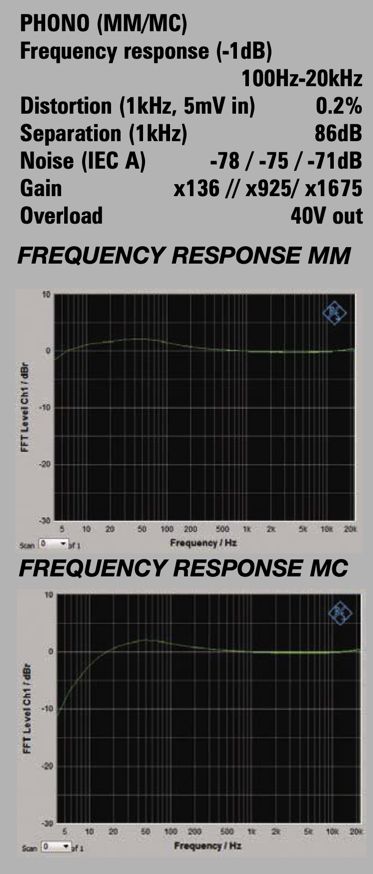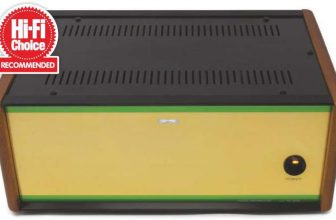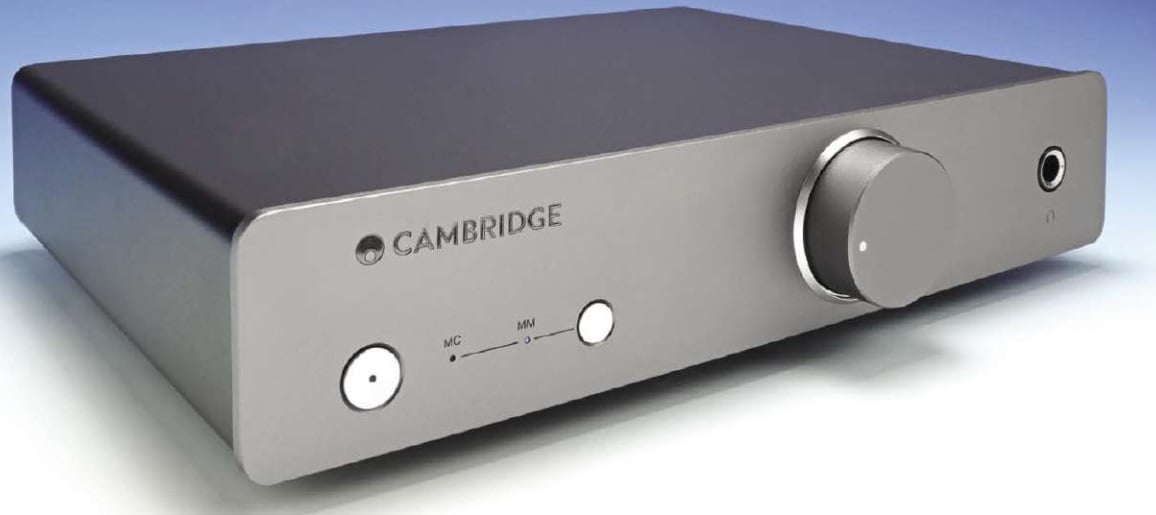SYNTHESIS ROMA 79DC Review – Roma Play

From Italy the Synthesis Roma 79DC tube phono stage, reviewed by Noel Keywood. Read our SYNTHESIS ROMA 79DC Review.
A tube phono preamplifier”, as Synthesis of Italy call it, gives best from – but they are rare.To capture the romance of vinyl, the Roma 79DC I am taking a close look at here, is just such a rarity – one suitable for both moving magnet (MM) and moving coil (ML) cartridges.
There’s a reason a tube (valve) phono preamp is rare – valves are noisy, too noisy for low output moving coil cartridges.There are two work-arounds: use an input transformer or use an input transistor.Transformers are superquiet but expensive: transistors are quiet enough and less expensive.
Synthesis go the transistor route, so with ML this is effectively a hybrid design fitted with “ultra low noise JFET” transistor input say Synthesis.With MM however, it’s a pure all-valve phono stage.
What to make of this? The transformer route with ML is preferable – it’s my choice – but the FET transistor route produces a very nice result and it doesn’t require a transistor bias current to be passed through the cartridge, as it is through most silicon chip (non-FET) phono stages.
But how about MM? Treated as a poor cousin to ML. today’s MMs are far better than most give then credit for.The gap between the Audio Technica VMS-750SH I like to use and moving coils isn’t so great. In the 79DC MM gets connected straight into an ECC83, known for its rich sound. If you want to run MM through valves then, the Roma 79DC looks promising.
That’s the basic proposition on offer here. Synthesis package three valves, plus transistors and other components, onto one circuit board in a case 260mm wide, 380mm deep and 95mm high.Weighing 5kg it’s a sturdily built package, with 20mm thick machined alloy fascia. Behind sits a conventional folded steel chassis with folded steel top cover.
Synthesis have their own unusual control methodology, but it’s hassle free – no mechanical DIP switches to change.A single push button on the font panel cycles through MM. ML or MC+.The first two settings provide standard gain, whilst the last adds extra gain to ML to cope with low output designs.
Select MM and the left control knob, a rotary actuator, offers a range of parallel input capacitance values.This was a useful way to brighten up warm sounding cartridges in the 1970s but is all but redundant now, modern designs not sounding warm.
Select MC and the actuator then alters input resistance in eight steps from 25 Ohms up to 1000 Ohms (Ik Ohms). The standard of 100 Ohms is provided and 330 and 1000 Ohm options suit high output moving coils.Values below 100 Ohm are experimental: they damp the electrical generator a bit more and can sound slightly‘darker’ but differences are slight I’ve found.
All this loading information is shown on a small luminescent screen populated by blocky low res characters, but they’re large and easily legible in a dimly lit room.You won’t be looking from far away though because there is no remote control, nor a volume control. No balanced XLR inputs or outputs either: this is a simple unbalanced stage with phono sockets, as a glimpse of the rear reveals.The chassis houses a linear power supply to feed plenty of volts to the valves, so no external wall-wart power supply either.
Mains earth is connected directly to chassis and the earth terminal, there is no ground lift switch.A simple and safe arrangement but the cartridge/arm will need to be earth isolated or the earth cable not connected to avoid hum. One ECC83 twintriode provides gain for MM on each channel, whilst an ECC82 twin-triode acts as a cathode follower output stage, one half on each channel.

AJFET transistor provides gain on each MC input, around x I being needed here – easy enough to provide. It’s likely the JFET stage feeds the ECC83 valve stage so you get hybrid amplification for MC but pure valve amplification for MM, as mentioned earlier.
SOUND QUALITY
The Synthesis Roma 79DC was connected to our Creek Voyage 120 amplifier that in turn fed Martin Logan ESL-X hybrid electrostatic loudspeakers through Chord Company Signature Reference loudspeaker cables. Signal input came from our Timestep Evo modified Technics SL-I2I0 Mk2 Direct Drive turntable, with SME309 arm. For MM I used an Audio Technica VM750 SH moving magnet (MM) cartridge and for moving coil (MC) an Audio Technica OC9X SH.

Measurement had shown significant bass lift (see Measured Performance) so I kicked off with an album that has steady strong lows from synthesiser, Alison Goldfrapp’s Supernature, since you have to use an album that has deep bass before you can hear what is happening to it. And here the Roma 79DC came across as very obviously bass heavy, to the extent that there was a dominant low drone.Worse, Ms Goldfrapp’s voice became thick and dense sounding because the lift was affecting her lower vocal frequencies, as well as deep bass. Further up the band the sound cleared to become pleasantly open and detailed, as expected from the valve line-up. There was a nice sense of air and space, but this was overwhelmed by what was happening lower down the scale. With Hugh Masekela’s Uptownship, from his LP Hope, opening kick drum was big and fat sounding and the rolling bass line that followed overly obvious.Yet the man’s trumpet work shone out beautifully and highs were strong and sonorous. Ignoring the bass – difficult at high volume – the Roma rather wrapped it all up. Spinning albums that lacked recorded lows the MC stage was nice enough, but I am scrabbling to find a plus point here.

CONCLUSION
Well built and easy to use, this hybrid FET/valve phono stage from Synthesis of Italy has the potential to sound very good.There’s nothing quite like listening to LP through valves – and some I span sounded suitably lovely through 79DC sounded as lovely as valves can sound in this role.
Turning volume down let bass fade backward (due to the ear’s lessening sensitivity at low levels) so it became less obvious, or even a benefit as a form of ‘loudness control’. But this is a bit of an ad- hoc benefit.
LPs without bass, such as the Trondheim Soloists playing Mozart Violin Concertos, fared differently. Here strings had a delicious lushness to them, yet were vividly clear, and Marianne Thorsen’s violin fairly soared in front of them.There was nothing not to like here; quite the opposite I heard what is possible from a good MM cartridge feeding straight into an al I-valve phono stage.
The picture did not change much with MC. Again, bass overwhelmed with Supernature and Alison Goldfrapp’s voice was thickened.The presence of a warp filter here wasn’t obvious subjectively; I heard higher frequencies where the ear is more sensitive.
Spinning Here Comes The Sun from the 2019 re-master of Abbey Road bass was again excessive in level and soft in quality, whilst vocals were thickened in texture and not as I know them from this classic album. Unfortunately, when a product introduces fundamental alteration to a classic track like Here Comes The Sun I have to object.
For edification and relief I fired up our Icon Audio PS3 Mkll allvalve phono stage, then a Pro-Ject RS2 transistor phono stage – and got to hear The Beatles as I know them – and this track as I know it. The Roma 79DC’s interpretation wasn’t acceptable to me and that the 79DC. However, not many: bass level was so high as to make low frequencies intrusive, even affecting vocals, due to inaccurate RIAA equalisation Making this a phono stage I could not live with, but I guess some may like it; Synthesis obviously seem to think so.
THE ISSUE OF LIFT
There’s an argument for lifting LP bass slightly, to add a little heft. I’ve done it by using the third-order subsonic filter tuned to provide +0.5dB lift at 40Hz, adding subtle extra weight. Lifting bass by +2dB is however excessive and blights this design in obvious fashion subjectively. At low listening levels some may like the effect, but turn volume up and it overwhelms.
The bass lift introduced by Synthesis in this phono stage is obvious and skews the intentions of artists and producers; I know how Abbey Road the album I used has been balanced by Abbey Road the Studio, since I live close by and have talked to them about it. I feel sure they would not appreciate this new mix. Huge amounts of knowledge and effort went into getting the re-master truthfully accurate and the 79DC altered it all.
Technically, the RIAA 318/3180pS time constants need correction here, usually just a matter of altering a few component values. It’s easy for Synthesis to get this right.
MEASURED PERFORMANCE
Frequency response with both MM and MC had bass lift below 200Hz, reaching a maximum at 50Hz of +2dB – enough to be easily audible. This amount of lift is strong and almost certainly intentional, rather than a component tolerancing error. Additionally, MM has no subsonic filter, gain reaching flat to 4Hz, whilst MC does have a filter, gain falling rapidly below 16Hz to be -8dB down at 5Hz. This will more alleviate cone flap caused by raised bass gain than suppress LP ripples, but there is some useful attenuation below 10Hz for MC.
Gain values were reasonably conventional at x136 (43dB) for MM, x925 (59dB) for MC and xl 675 (65dB) for MC+.
As always with phono stages overload was set by output swing which with valves is very high, in this case 40V. That translated into very high input overload values – no less than 24mV for MC+ for example.
Equivalent input noise – a true measure of perceived noise – was high at 0.8/AZ for MM, but reasonably low at 0.2/A/ for MC and MC+. Although MM is high due to the direct valve input, MMs produce around 32/A/ thermal noise, making the preamp’s input noise inconsequential. NK

GOOD – worth auditioning
VERDICT
Henley Audio
+44 (0)1235 511166



